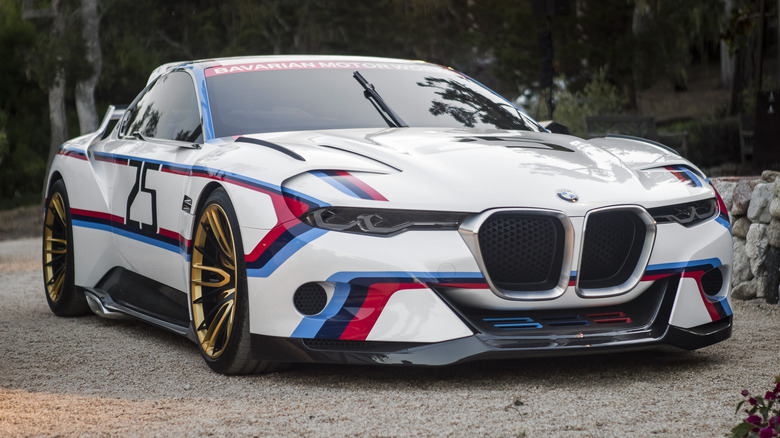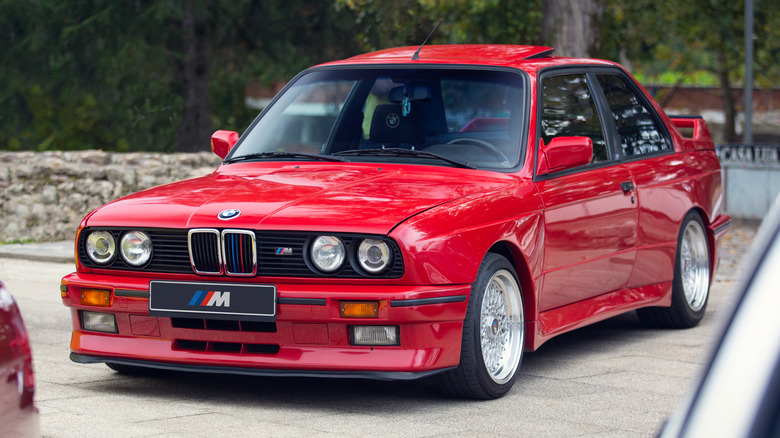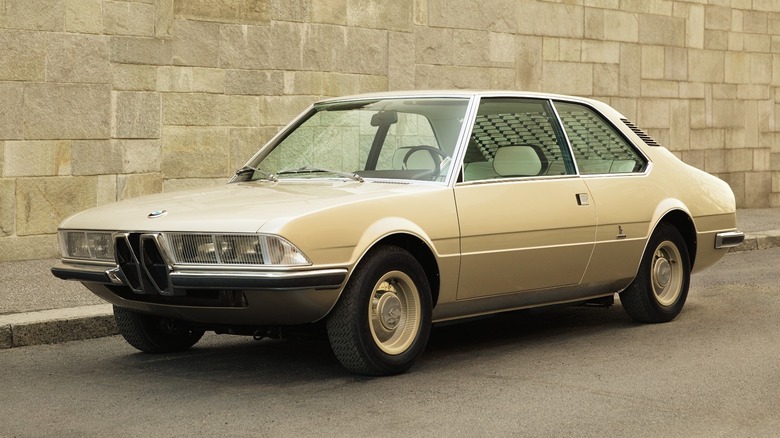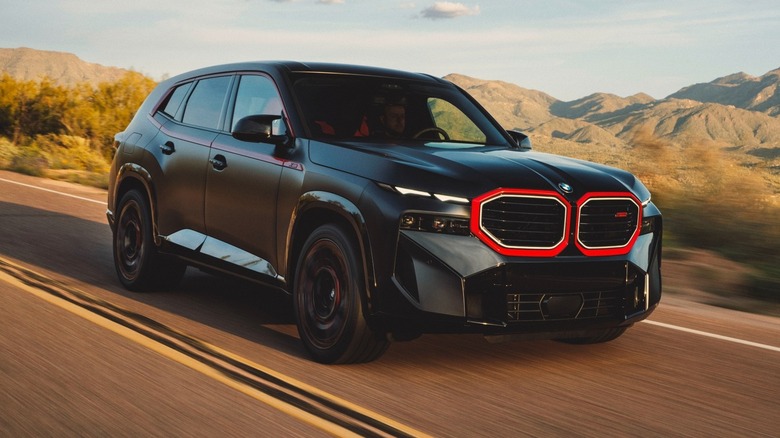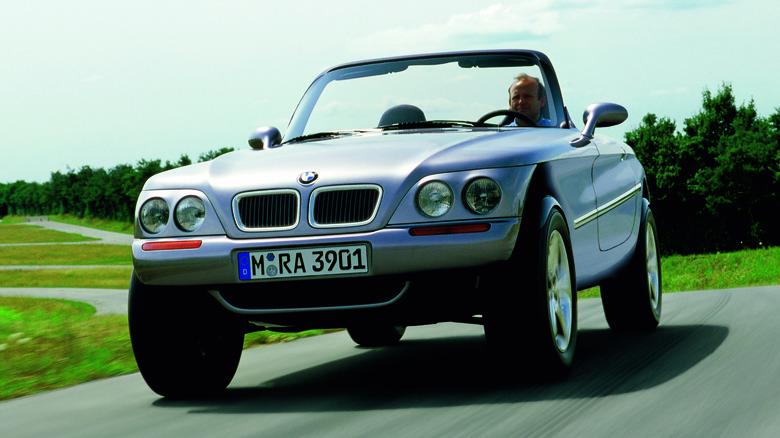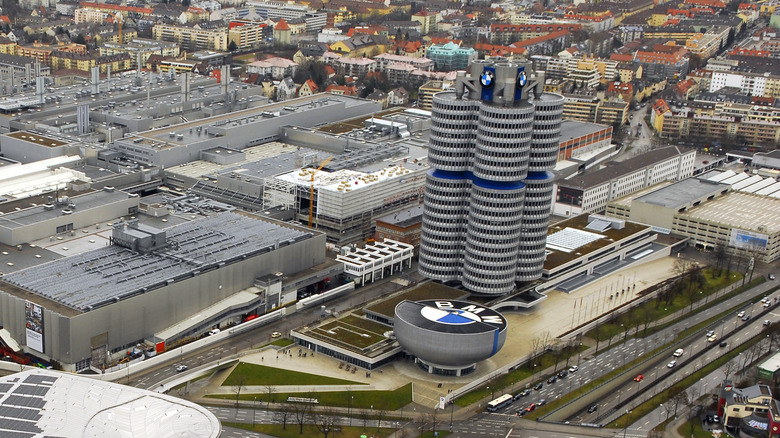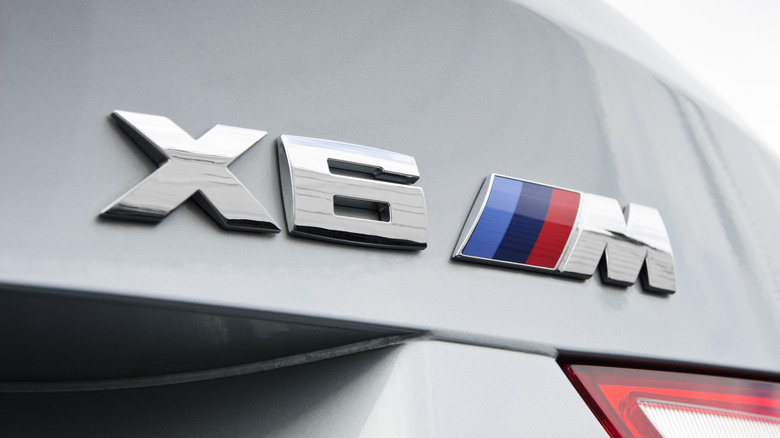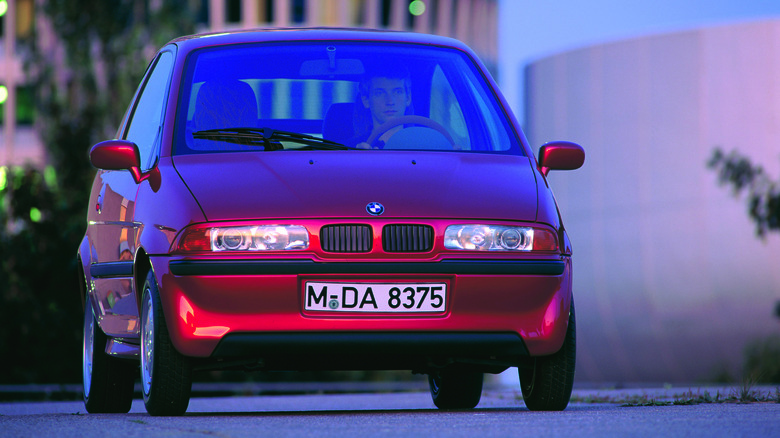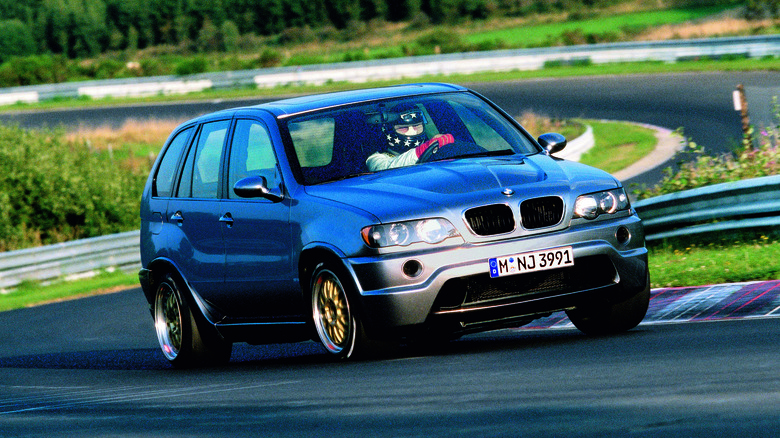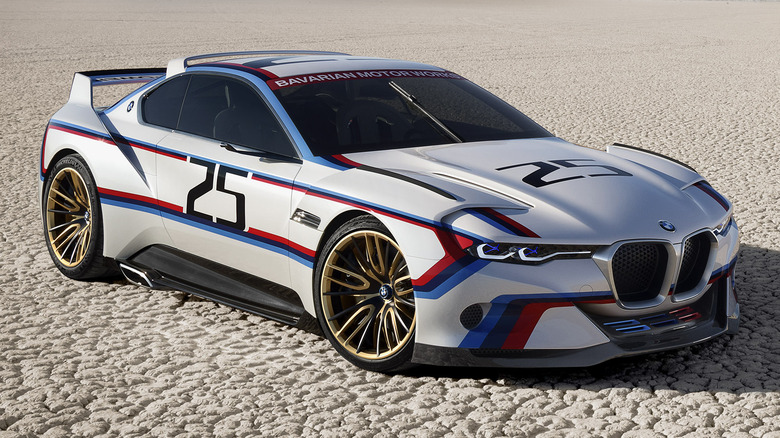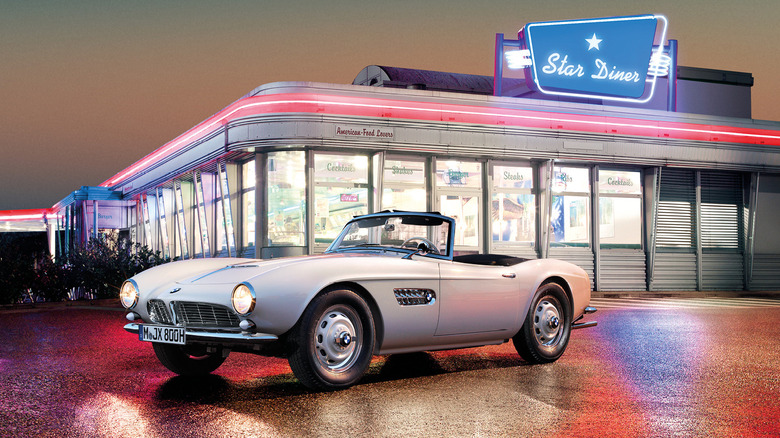10 Little-Known Facts About BMW For Car Enthusiasts
From the M1 to the i3, BMW has always had a reputation for making innovative cars. It was first formed as a maker of aircraft engines, but after the Second World War, transitioned solely to making motorcycles and passenger cars. After financial trouble in the '50s, the following decades saw the brand expand significantly, building class-leading automobiles and establishing itself as one of Europe's premier automakers.
Today, BMW produces a wide range of vehicles, from its best-selling "X" line of SUVs and crossovers to the luxurious and exclusive i7 limousine. Its portfolio of subsidiaries also includes Mini and Rolls-Royce, the latter being responsible for some of the most expensive cars ever built. With so much heritage, and so many vehicles in its back catalog, some pieces of the brand's story inevitably get overlooked by enthusiasts. We've dug out a selection of stories from the archives that most fans won't have heard before, from pioneering prototypes to the hidden history behind the brand's greatest models.
The BMW M3 was originally designed as a Group A homologation special
The BMW M3 is today one of the brand's best-known models, widely considered the benchmark in its segment against which all challengers are measured. However, it wasn't originally envisioned to be so influential to BMW's history. Rather, the first E30 M3 was built as a homologation requirement to allow BMW to enter Group A racing in the DTM championship. To qualify, a minimum of 5,000 examples had to be built over a 12-month period, but to BMW's surprise, demand for this new racing-derived 3 Series quickly outpaced supply.
Its response was to increase production numbers, and eventually, a total of 18,000 examples were sold before a second-generation M3 was unveiled based on the E36 3 Series. Across that run, various special editions of the car were unveiled, with the M3 Sport Evolution being the most powerful. It produced 238 horsepower from its 2.5L naturally aspirated four-cylinder, up from the 200 horsepower on offer from the 2.3L unit in the standard M3. In total, just 600 examples of the M3 Sport Evolution were sold, making them sought-after collectors' grails today.
BMW unveiled a concept designed by Marcello Gandini... then lost it
Marcello Gandini is best known for designing automotive icons like the Lamborghini Miura and Countach, but he also worked on an innovative concept for BMW while under contract at Bertone. Christened the Garmisch, the car was unveiled at the 1970 Geneva Motor Show, creating plenty of buzz thanks to its unusual design and Italian influences. However, after its appearance at the show, something odd happened: the concept mysteriously disappeared.
No one knows exactly what happened to it, but it appears BMW somehow lost the car after the show or at least forgot to document its whereabouts. It remained forgotten until Adrian van Hooydonk, BMW's chief designer, found an old picture of it in an archive decades later. Very little information was retained about the car, but with the help of Gandini, van Hooydonk and his team were able to create an almost exact replica of the original that was unveiled at the Concorso d'Eleganza Villa d'Este in 2019. As for the fate of the original concept? That remains one of automotive history's many mind-boggling mysteries.
The most powerful production BMW ever made is an SUV
Ask enthusiasts to name the most powerful BMW car to date and they'll probably come up with a list of M-badged sports cars like the M3, M5, and M8. However, none of those hold the crown. BMW's most powerful car does sport an M badge, but not the one that will please the purists. With 738 horsepower on tap from its hybrid V8 powertrain, it's the XM Label Red that sits in the top spot.
To say its looks are controversial would be an understatement – Top Gear rather brutally described it as "put[ting] lipstick on a pig" — but it's hard to argue with its performance credentials. With the M Driver's Package optioned, the SUV is good for a 0-60 mph time of 3.7 seconds and can reach a top speed of 175 mph.
BMW was well aware of the controversy that an SUV developed specifically for the M line would cause, and so tried to prove the XM's capabilities to enthusiasts by entering it into the Pikes Peak International Hill Climb in 2023. Unfortunately, that initial outing ended with driver Matt Mullins crashing the car into a tree. The team returned later in the year with a second car and did manage to set a class record with the XM.
BMW once built a prototype off-road sports car
The Z1, Z3, Z4, and Z8 remain the only Z-branded BMWs to make it to production, but there is a surprisingly large range of prototype Z cars that never made the cut. The Z13, for example, was a design study featuring a McLaren F1-style central driving position. The Z21 was closer in design to a Caterham than anything that had previously emerged from the Bavarian manufacturer. One of the strangest of all was the Z18, which BMW referred to as the "first off-road roadster."
Unveiled in 1995, the Z18 holds the distinction of being the brand's first 4x4. Despite its high riding position and chunky tires, the family connection to BMW's existing Z cars is clear — it looks like a proper BMW sports car, just one built for the dirt rather than the road. The interior was waterproof, and the body panels were made of plastic so they could be cheaply replaced if they got scratched or cracked while on the trail. It was deemed too strange to ever be seriously considered for production, but its V8 engine was reportedly eventually used in the production X5.
BMW headquarters is shaped like a four-cylinder engine
At the start of the '60s, BMW was still a fairly small automaker. However, by the end of the decade, its production figures had increased drastically, which pushed its existing facilities to breaking point. To keep up with the demand for its cars, BMW needed to expand, and fast. New factory facilities were built or acquired from other companies, but the brand still didn't have anywhere to put its office staff, instead housing them in rented offices around Munich. This quickly proved to be a very inefficient way to run the company. After soliciting ideas from architects for a new headquarters, BMW signed off on an ambitious design by Vienna-based Karl Schwanzer in 1968.
The design, of four cylindrical towers linked by a central connector, was created to resemble a four-cylinder engine while providing an innovative way to ensure each open-plan office received maximum sunlight and ventilation. Rather than being built from the ground up, it was built as the world's tallest suspended building at the time. Four supporting arms were built to hold up the towers, each protruding from the central core. That allowed the upper floors of the building to be constructed first, then slowly hauled upwards while the lower floors were simultaneously built underneath. Construction of the tower was finished in 1973, and aside from an interior refit in the mid-'00s, it has remained unchanged ever since.
BMW's M logo was reportedly the result of a canceled Texaco sponsorship
The BMW M logo with its tricolor stripe is one of the most distinctive motifs in the car world, but its origins can be traced back to an aborted sponsorship deal in the '70s. That's the opinion of BMW Group Classic historian Marc Thiesbürger, who studied material from the brand's archives to investigate the story behind the design. When BMW M was founded as the automaker's dedicated motorsports division, bosses were in talks to close a major sponsorship deal from Texaco, which would see the oil giant's logo incorporated into the M team's livery.
Drawings from the era showed that team bosses had already begun designing the liveries that a Texaco-sponsored M car would use, and reportedly chose three colors to signify the partnership. A blue stripe would represent the colors of Bavaria, already in use on the BMW logo, a red stripe would represent Texaco, and a central violet stripe would represent the mix of the two brands.
Texaco reportedly pulled out of the sponsorship deal at the end of 1972, but BMW M bosses chose to stick with the color scheme. An alternative reasoning was later given for the color choice: the red stripe represented motorsport, with violet now representing the mix of BMW and motorsport. Not everyone within BMW agrees with this story, and multiple designers and executives later claimed responsibility for the iconic palate.
BMW developed an EV city car in the 1990s
The Bavarian manufacturer had been experimenting with electric cars as early as 1972, when it produced two EV prototypes in time for the 1972 Munich Olympics. However, these early efforts were quite primitive, with the resulting car only sporting a range of 19 miles under normal city driving conditions. Further experimentation continued over the following decades, and by the early '90s, BMW's EV technology had advanced significantly. In 1991, the brand unveiled the E1, a compact city car with a city driving range of up to 100 miles and a top speed of around 75 mph.
This was no mere design study either — outlets including Autocar were invited to drive the E1 upon its unveiling, and praised its practicality and "tidy" handling. It was, per Autocar, "perhaps the first fully thought-through and genuinely usable electric car," but it never made it to production. Part of the reason for its development was the announcement of a zero-emissions mandate in California, due to be implemented in 1998, but when that was dropped, so was BMW's EV development. A lack of charging infrastructure was also cited as a stumbling block at the time, which the U.S. continues to struggle with today.
BMW once put a 700 horsepower McLaren F1 engine into an X5
The "sport" in "Sport Utility Vehicle" is often a misnomer, but not in the case of the BMW X5 Le Mans. This prototype SUV, unveiled in 2000, sported a 6.1L racing V12 engine under the hood, borrowed from BMW's Le Mans race car. The engine was the same one that had also appeared in the McLaren F1 — although the X5 LM's V12 was even more powerful than the unit in the record-breaking hypercar.
The X5 LM was put together as a technical demonstration to test the limits of BMW's SUV platform, and it quickly proved to deliver unprecedented performance. It shattered the class lap record at the Nordschleife, holding onto the crown for nearly 20 years. It also set a top speed run of 193 mph. Despite its record-breaking talents, however, it was never considered for production. It was always intended to be just a test bed for the brand's performance tech, and so after those tests were completed, it was retired into storage. Today, it remains a hidden gem that few enthusiasts remember even existed.
BMW built a successor to the 3.0 CSL in 2015
Considered by many to be one of the greatest BMWs ever built, the 3.0 CSL dominated on the track, racking up an impressive cabinet of trophies as well as charming fans with its distinctive styling and BMW M livery. The CSL name has only been used sparingly in the decades since, being revived once for the fastest, rarest variant of the E46 M3, and again in 2015 with the unveiling of the 3.0 CSL Hommage R.
Sporting BMW M colors and the wide, aggressive stance of the original, the 3.0 CSL Hommage R debuted at the Pebble Beach Concours to commemorate the 40th anniversary of the classic racer. It drew praise from the media and public alike, and generated inevitable speculation about a future production version. BMW never confirmed any plans to take the car past the concept stage, and sadly, no production car ever emerged.
BMW's Classic division restored Elvis Presley's 507 roadster
Elvis might be most famous for his love of Cadillacs, but the King of Rock 'n' Roll collected a wide range of cars. Among his earliest purchases was a BMW 507, which he bought when stationed in Germany during his time in the U.S. Army. The car was originally white, but after female fans kept leaving red lipstick marks on its bodywork, Elvis had it repainted red. He also replaced the engine, reportedly bumping the 507's power output up to around 150 horsepower.
Presley would eventually trade the car in after he returned to America, with it later passing through several owners, ending up as a race car in Alabama with a Chevy V8 under the hood. After its racing career ended, the 507 was sold on and eventually put into long-term storage, with its owner aiming to fully restore it to its former glory. Eventually, he reached out to a journalist who put him in touch with BMW's Classic division, with the automaker later purchasing the car outright to give it the restoration its previous owner had hoped for. BMW's restoration team reproduced components using 1950s techniques to ensure authenticity, and the finished car was eventually unveiled at the Pebble Beach Concours in 2016.
